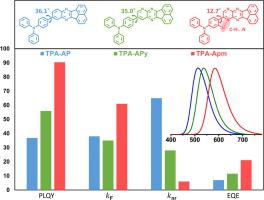Chemical Engineering Journal ( IF 13.3 ) Pub Date : 2022-06-21 , DOI: 10.1016/j.cej.2022.137717 Hao-Yu Yang , Heng-yuan Zhang , Ming Zhang , Xiao-chun Fan , Hui Lin , Si-Lu Tao , Cai-Jun Zheng , Xiao-Hong Zhang

|
As one of the three primary colors, red organic light-emitting diodes (OLEDs) are indispensable in practical applications. However, red emitters are generally subject to severe non-radiative exciton loss due to their narrow energy gap. In this work, three new thermally activated delayed fluorescence (TADF) emitters were developed, namely 4-(acenaphtho[1,2-b]quinoxalin-9-yl)-N,N-diphenylaniline (TPA-AP), 4-(acenaphtho[1,2-b]pyrido[2,3-e]pyrazin-10-yl)-N,N-diphenylaniline (TPA-APy), and 4-(acenaphtho[1,2-b]pyrazino[2,3-e]pyrazin-9-yl)-N,N-diphenylaniline (TPA-APm), employing a series of finely modified acenaphtho[1,2-b]quinoxaline (AP) derivatives as acceptor units. Among three TADF emitters, an intramolecular hydrogen bond is formed between the donor (D) and acceptor (A) units in TPA-APm. Consequently, the overlap of the frontier molecular orbitals (FMOs) of TPA-APm can increase appropriately, and the fluorescence radiative rate (kF) of TPA-APm is nearly twofold than that of TPA-AP and TPA-APy. Furthermore, the non-radiative decay rate (knr) of TPA-APm is less than that of TPA-AP and TPA-APy by an order of magnitude, which is attributed to the improved molecular rigidity caused by intramolecular hydrogen bond. As a result, TPA-APm-based OLEDs achieved a multiplied external quantum efficiency (EQE) of 21.1% with the electroluminescence peak at 590 nm, comparing to only 7.0% and 11.5% for the TPA-AP-based and TPA-APy-based devices, respectively. These results demonstrate appropriate intramolecular hydrogen bond can suppress the influence of non-radiative decay by simultaneously enhancing molecular rigidity and facilitating the fluorescence process, and have great potential in the design of efficient red TADF emitters.
中文翻译:

通过引入分子内氢键提高红色热激活延迟荧光发射器的效率
作为三基色之一,红色有机发光二极管(OLED)在实际应用中不可或缺。然而,红色发射器由于其狭窄的能隙,通常会遭受严重的非辐射激子损失。在这项工作中,开发了三种新型热激活延迟荧光(TADF)发射器,即4-(苊[1,2-b]quinoxalin-9-yl)-N,N-二苯苯胺(TPA-AP)、4-(苊并[1,2-b]吡啶并[2,3-e]吡嗪-10-基)-N,N-二苯基苯胺(TPA-APy)和4-(苊[1,2-b]吡嗪[2, 3-e]pyrazin-9-yl)-N,N-diphenylaniline (TPA-APm),采用一系列精细修饰的苊并[1,2-b]喹喔啉 (AP) 衍生物作为受体单元。在三个 TADF 发射体中,在 TPA-APm 中的供体 (D) 和受体 (A) 单元之间形成了分子内氢键。最后,TPA-APm 的k F ) 几乎是 TPA-AP 和 TPA-APy 的两倍。此外,非辐射衰减率(k nr) TPA-APm 比 TPA-AP 和 TPA-APy 小一个数量级,这归因于分子内氢键引起的分子刚性提高。结果,基于 TPA-APm 的 OLED 实现了 21.1% 的倍增外量子效率 (EQE),电致发光峰值位于 590 nm,而基于 TPA-AP 和 TPA-APy- 的 OLED 分别为 7.0% 和 11.5%。基于设备,分别。这些结果表明,适当的分子内氢键可以通过同时增强分子刚性和促进荧光过程来抑制非辐射衰变的影响,在设计高效的红色 TADF 发射器方面具有很大的潜力。









































 京公网安备 11010802027423号
京公网安备 11010802027423号